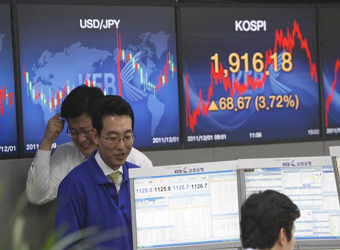Asian stocks crept cautiously higher on Monday encouraged by record highs on Wall Street, though an on-going credit squeeze in China created some uncertainty while adding to pressure on emerging market currencies.
Early relief at a dip in China’s benchmark short-term money rates evaporated when they swung higher again, reaching 9.8 percent at one stage.
Yet stocks in Shanghai still managed to bounce 0.4 percent .SSEC, lessening the fallout across the region.
Volumes were very light with Tokyo on holiday on Monday and Christmas almost here. South Korea’s main index .KS11 added 0.6 percent while S&P 500 futures gained 0.3 percent.
MSCI’s broadest index of Asia-Pacific shares outside Japan .MIAPJ0000PUS firmed 0.4 percent.
Sentiment was underpinned by upbeat data on U.S. economic growth and the resilience of stocks to the Federal Reserve’s decision to start scaling back its bond-buying stimulus.
On Wall Street, the Dow Jones .DJI ended Friday up 0.26 percent, while the S&P 500 Index.SPX added 0.48 percent. Europe’s broad FTSEurofirst 300 index .FTEU3 rose 0.45 percent.
The dollar was idling at 104.05 yen on Monday after scoring a fresh 5-year high at 104.64 last week. Dealers cited option barriers at 104.75 and 105.00 as the next target for bulls.
The euro was a shade firmer at $1.3678, but well short of last week’s $1.3811 peak.
The single currency was only briefly troubled on Friday when Standard & Poor’s cut its supranational long-term rating on the European Union to AA-plus from AAA, citing rising tensions on budget negotiations.
Yields on benchmark 10-year Treasuries were holding at 2.89 percent having risen just 2 basis points last week even as the Fed announced its tapering.
In Asia, all eyes were on China after the country’s central bank sought to allay fears of a cash crunch on Friday, saying it has added $50 billion in three days to the interbank market.
Rapid credit growth in the world’s second-biggest economy has worried the Chinese authorities, who fear rising debt levels are fuelling asset bubbles.
The People’s Bank of China (PBOC) injected more than 300 billion yuan into the interbank market in response to rising rates, but hinted that banks have work to do if they want to avoid a cash crunch.
Worries about the banking system contributed to a 2 percent drop in Shanghai shares on Friday.
The combination of Fed tapering and tighter China interest rates could weigh on emerging market currencies and assets, as it did back in June.
Currencies from Indonesia to Malaysia and Thailand all came under pressure last week and even the Korean won lost a little of its strength. The Thai baht also has domestic political troubles to contend with and hit its lowest since early 2010 on Monday.
Still, analysts at Deutsche argued that emerging markets (EM) Asia could weather any outflow of capital.
“Asia remains best placed — the reform effort in China and India is significant; and the smaller, more open economies will benefit disproportionately from strengthening demand in the U.S. and Europe,” said Drausio Giacomelli in a note to clients.
“The value of EM as a diversifier will increase once uncertainty about the future of U.S. monetary policy eases into 2014,” he added, noting that emerging markets were just a fraction of the global portfolio at around 3 percent or lower.
In commodity markets, gold has been getting less precious by the day due to the winding back of U.S. stimulus and a general lack of global inflationary pressure.
The metal was pinned at $1,201.30 on Monday after carving out a six-month low of $1,187.80 last week. If prices stay here the metal would have shed 28 percent this year, the largest annual loss in 32 years.
In contrast, oil prices have been supported by a positive outlook for fuel demand in the United States and reduced Libyan supply. Brent crude was up a cent on Monday at $111.78 a barrel, on top of gains of almost 3 percent last week.
U.S. oil futures dipped 12 cents to $99.20.
Source: Reuters





